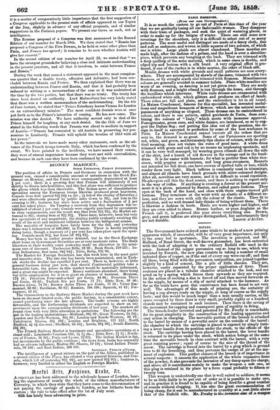PARIS FASHIONS.
(From our own Correspondent.)
it is so much the custom to go out of Paris at this time of the year that we are gradually losing all our fashionable women. They disappear with their train of packages, and seek the quiet of watering places, in order to make up for the fatigue of winter. There are still some new coverings for the shoulders, only it is difficult to select out of so many patterns. The most useful and distingue are made of a fancy cloth, fine and soft as cashmere, and woven in little squares of two colours, of which one is white. Large plaids are almost abandoned. These mantles are made high, after the fashion of a pelisse, and the hood is over a shoulder- piece, which prevents any bungling at the back. They are trimmed with a deep quilling of the same material, which in some cases is double, and edged.top and bottom with a silk braid. A very original effect is pro- duced, if one of the ruches is in white merino, the other of black silk.
Muslin dresses with white grounds and small patterns are seen every- where. They are accompanied by shawls of the same, trimmed with two flounces, or by straight scarfs also trimmed with flounces. Miscellaneous colours are generally avoided in summer toilets. Plain white mualins are worn of an evening, as dancing is not yet given over. They are made with flounces, and a bright riband is run through the hems, and through the bouillons which intervene. White tulle dresses are ornamented with embroidered white silk, which glitters and produces an effect of beads. These robes are full and plain, and the embroidery is let in all round. La Maison Coudioimal, famous for this apecialite, has invented medal- lions and magnificent bouquets of flowers, which are the natural accom- paniments of anything so elegant. These dresses can be embroidered in colour, and there is one pattern, called guirlande de Turin, from corn- biasing the colours of "Italy," which meets with immense approval. Pomegranates, green corn, and white daisies, are interlaced, so as to sug- gest the Italian flag ; and putting this idea out of the question, the de- sign in itself is executed to perfection by some of the best workmen in Paris. La Maison Couchonnal cannot execute all the orders that are sent in, the demand is so great. Some of our Parisiennes are sporting red, white, and green, and fortunately this choice of (*lours, with its poli- tical meaning, does not violate the rules of good taste. A white dress trimmed with green and red is by no means an unpleaaing spectacle, and it can be very well managed, by wearing green ribands all down the side of the skirt, and a bunch of red flowers in the corsage and in the head- dress. It is far easier -with bonnets; for what is prettier than white rice- straw, with poppies or geraniums, and long grass streamers. Bonnets not intended for full dress, can have crowns of spotted tulle or lace, which render them very light. Black taffetas is constantly used in trimmings, and almost all ribands have black grounds with straw-coloured designs. After all, novelties are very scarce, and it is difficult to avoid repetition. Shopkeepers call this the dead season, and there is nothing to report only in the way of trifles. If anything is creating a fureur at the present mo- ment it is a glove, patented by Banton, and called gents Italiens. They open at the back of the hand, and close with three engine-turned gilt buttons. They terminate at the wrist with an elastic of a different co- lour, and they are sown with silk the colour of the elastic. They fit to perfeation, and no well dressed lady thinks of being without them. There is likewise a fashion in boots. Heels are worn higher and higher, and they are even added to-shoes. Bronze leather, or peau Anglaise as the French call it, is preferred this year above everything else. Brown, grey, and green taffetas are always distinguished, but unfortunately they
























 Previous page
Previous page